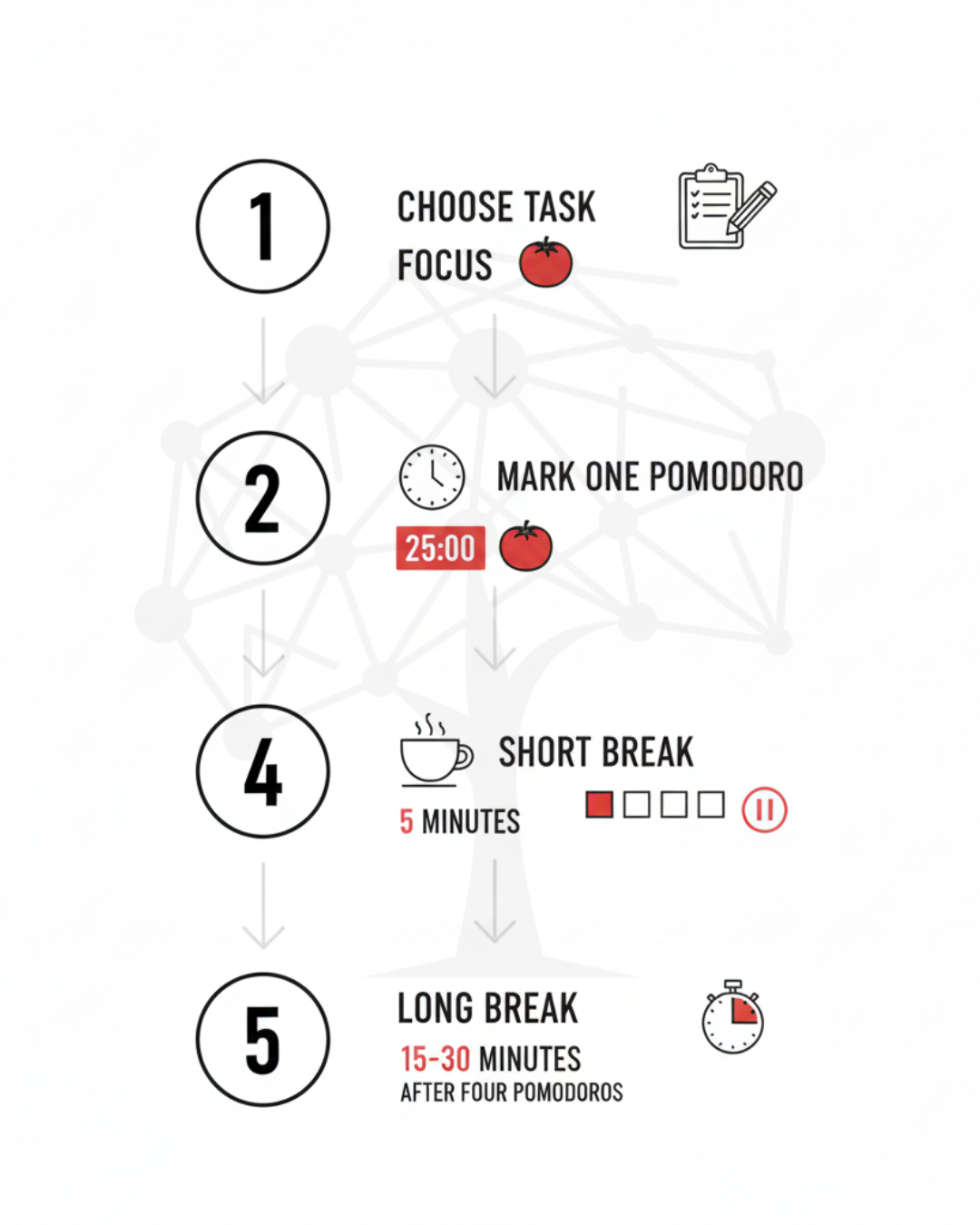
Struggling to focus or feeling fried by mid-afternoon? The Pomodoro Technique turns time into a friendly, motivating nudge—using 25-minute intervals and a simple Pomodoro timer to help you start, stick with, and finish work.
Quick Summary
Work in short, protected sprints with purposeful breaks to maintain energy.
Plan before you start; review and preview to keep momentum.
Customize intervals (25/5, 50/10, 90/20) to match task depth and your focus curve.
Track Pomodoros per task to improve estimates and reduce overwhelm.
In this guide, you’ll learn the core mechanics, why the cadence works psychologically, and how to adapt it to your brain and schedule (students, remote workers, and folks with ADHD especially).
We’ll walk through a no-fluff, five-step setup, fix common pitfalls like interruptions, and share pro tips for breaks and planning. Finish with a printable planner and a one-cycle challenge so you can test the method today and feel the difference by your next deep-work block.
What Is the Pomodoro Technique?
The Pomodoro Technique is a time-management method created by Francesco Cirillo that breaks work into short, focused sprints (“Pomodoros”) separated by deliberate breaks. “Pomodoro” is Italian for tomato—named after the tomato-shaped kitchen timer he used. The power of the method is its simplicity: it lowers the emotional barrier to starting, makes progress visible, and builds sustainable focus without burnout.
Definition Shortly:
The Pomodoro Technique is a time management method that uses a timer to break down work into 25-minute focused intervals, separated by short 5-minute breaks.
5-Bullet Summary
Work in focused 25-minute sessions called “Pomodoros.”
Take a 5-minute short break after each Pomodoro.
After four Pomodoros, take a longer break of 15–30 minutes.
The technique aims to improve focus and reduce mental fatigue.
It helps break large, intimidating tasks into manageable chunks.

5-Step Solution
Choose a task you want to accomplish.
Set a timer for 25 minutes and work on the task without interruption.
When the timer rings, stop working and mark one Pomodoro complete.
Take a 5-minute break to stretch, grab water, or rest your eyes.
After completing four Pomodoros, take a longer break (15–30 minutes).
Mini-summary: Pomodoro turns time into short, doable units to reduce overwhelm and keep your brain fresh.
Checklist: □ Pick a task and set a 25-minute timer.
How to Use the Pomodoro Technique in 5 Simple Steps
Before you press start, clarify your task list so each interval has a clear target. Then set your timer for 25 minutes and work uninterrupted—no email, no messaging, no extra tabs. When time’s up, log the Pomodoro (a tick mark or tally) and take a 5-minute break. After four Pomodoros, step away for 15–30 minutes. Guard your focus: when an interruption appears, capture it on a “later” list and return to the task. If the interruption is unavoidable, pause the session and restart a full 25 minutes afterward so your tracking stays accurate.
Mini-summary: Plan your work, protect the 25 minutes, and use breaks on purpose.
Checklist: □ Create today’s task list with 1–3 priorities before starting.
Why It Works: The Science Behind 25-Minute Focus
Short, timed sprints create productive urgency, making it easier to start—an antidote to procrastination. Regular breaks prevent mental fatigue, giving your attention system the recovery it needs to sustain output. Chunking large projects into Pomodoros reduces cognitive overload, while a steady stream of completions builds motivation and momentum. Over time, you train a repeatable rhythm: engage deeply, release, recover, repeat.
Mini-summary: Timers lower the barrier to starting; breaks protect energy; small wins fuel motivation.
Checklist: □ Break one large task into 3–6 Pomodoros.
Is the Pomodoro Technique Right for You? (And How to Adapt It)
Great fits include students (study blocks + recall breaks), remote workers (structure for fragmented days), and ADHD individuals who benefit from clear starts/stops and externalized time. Acknowledge drawbacks: 25 minutes can feel rigid for deep creative flow, and frequent breaks may disrupt a groove. Solution: custom intervals. Try 50/10 for medium-depth work or 90/20 for true deep work. For collaborative roles, batch meetings into one window and reserve Pomodoros for maker time. Treat the method as a framework—tune it to the task, your energy, and the context.
Mini-summary: Fit the rhythm to your work—customize intervals and boundaries to match task depth.
Checklist: □ Choose your default set: 25/5, 50/10, or 90/20.
Pro-Level Productivity Tips for Your Pomodoro Practice
Use breaks intentionally: stand, stretch, hydrate, or do a quick breathing reset—avoid doom-scrolling that hijacks the next block. Front-load your day: make the first Pomodoro a quick plan (priorities, estimates) and the last Pomodoro a review (what moved, what’s next). For learning or complex tasks, practice overlearning: spend 60–90 seconds at the end of each Pomodoro summarizing progress and previewing the next step—this improves retention and smoother restarts. Track Pomodoros per task for better estimating and future planning.
Mini-summary: Use breaks to recharge, bookend your day with plan + review, and preview the next move.
Checklist: □ Add a 90-second “what’s next” note before each break.

Your First Pomodoro Challenge + Free Planner
Ready to try it? Run one full cycle (4 Pomodoros) today on a single priority or a cluster of quick wins. Observe your focus, interruptions, and energy—then tweak interval lengths or break activities as needed.
Printable Planner (copy/paste to print):
Today’s Focus (Top 1–3):
1)
2)
3)
Pomodoro Log (□=done):
□ □ □ □ | Long break
Notes & Interruptions (later list):
-
-
Next Steps (end of day, 5 min):
-Prefer apps? Any simple Pomodoro timer works—kitchen timer, phone, or a dedicated app with 25/5 presets and stats.
Mini-summary: Test the method once to feel the rhythm; measure, then refine.
Checklist: □ Schedule four back-to-back Pomodoros with one long break.
Ready to turn these tactics into a durable system? Start with one 4-Pomodoro cycle today, then refine your interval lengths and break habits based on what you learn. For structured, step-by-step coaching, join Free Time Management course—build a weekly plan, master prioritization, and integrate the Pomodoro Technique into a sustainable routine that protects your energy and delivers consistent results.
Frequently Asked Questions
What if I’m “in the zone” when the timer rings?
Finish the thought, then break. If this happens often, extend your default to 50/10 or 90/20.
How do I handle constant interruptions?
Use a “later” list during the 25 minutes. For unavoidable ones, pause and restart a fresh Pomodoro afterward.
Do I need a special app?
No. Any timer works. Apps add stats, tagging, and reminders—helpful, not mandatory.
Can Pomodoro work for creative or engineering deep work?
Yes—with longer intervals (50/10, 90/20) and protected, calendar-blocked maker time.
How many Pomodoros should I do in a day?
UNKNOWN (varies by role and energy). Track your averages for 2 weeks and set a personal benchmark.
Can I use the Pomodoro Technique with team work or meetings?
Yes. Batch meetings into a fixed window and run Pomodoros for solo tasks between them. For pair work, agree on shared intervals (e.g., 50/10) and take synchronized breaks to keep momentum without fragmenting collaboration.